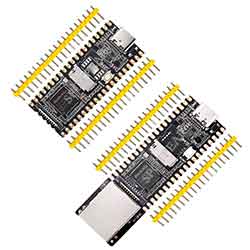- sales/support
Google Chat: zj734465502@gmail.com
- sales
+86-0755-88291180
- sales01
sales@spotpear.com
- sales02
dragon_manager@163.com
- support
tech-support@spotpear.com
- CEO-Complaints
zhoujie@spotpear.com
- sales/support
WhatsApp:13246739196
- HOME
- >
- ARTICLES
- >
- LuckFox
- >
- LuckFox Pico
Luckfox Pico RV1103【Tutorial on how to use UART】

The LuckFox Pico has three serial ports: UART2, UART3, and UART4. Among them, UART2 is the debug port.
The LuckFox Pico Plus has four serial ports: UART2, UART3, UART4, and UART5. Among them, UART2 is the debug port.
】Performing serial port testing using the GPIO sysfs interface:
1] View serial port:
root@linaro-alip:/home/linaro# ls /dev/ttyS*
/dev/ttyS3 /dev/ttyS4
##The serial port devices here are UART3 and UART4
2] Use the “stty” tool to query the serial port communication parameters:
linaro@linaro-alip:~$ stty -F /dev/ttyS3
speed 9600 baud; line = 0;
-brkint -imaxbel
##The default baud rate is 9600
3] Modify the baud rate, where ispeed is the input rate and ospeed is the output rate:
stty -F /dev/ttyS3 ispeed 115200 ospeed 115200
4] Disable echo:
stty -F /dev/ttyS3 -echo
## Disabling echo refers to the situation where the characters entered in the terminal or serial communication are no longer displayed on the terminal.
5] Operation process screenshot:

】Communicating with a Windows host:
Connect one end of the serial port module to the computer, and the other end to the physical pins 18 (GND), 19 (UART7_TX), and 20 (UART7_RX) of the LuckFox Pico.
Download and open PuTTY (or any other serial port software), select the serial port, and set the baud rate (default is 9600, please adjust it according to your actual modified value).
Execute the following command on the terminal of the development board to write the strings “Hello” and “world!” to the terminal device file using the echo command:
echo Hello > /dev/ttyS3
echo "world !" > /dev/ttyS3
The serial port debugging assistant on Windows will receive the content:

】Test the built-in sample program of the official SDK:
(The following operations need to be performed in the terminal of the Pico development board)
3] Run the test sample program:
chmod 777 ./luckfox_uart_test
## Grant executable permissions to the file
./luckfox_uart_test 3
##The parameter 3 in the example represents UART3.
4] Open the serial communication device to receive data:

TAG:
NVIDIA-acess User Guide
Raspberry Pi Secondary Screen
wide dynamic range
Raspberry Pi Pico 2 RP2350 Pico2 ARM Cortex-M33 And RISC-V Hazard3 520KByte 4MByte QSPI Flash
ESP32 1.5inch LCD
AV to RGB
Core3566102032
Milk V Duo
SpotPear
Raspberry Pi Pico 2 RP2350 1.28 inch Round LCD Development Board 240x240 Display Screen QMI8658 6-Axis
Raspberry Pi Pico
Raspberry Pi 0.96inch OLED
ESP32-S3 Development Board 1.47 inch LCD Screen Display 172x320 SD-Port LVGL USB
Raspberry Pi 5 Power
Raspberry Pi LCD display screen 1.3inch ST7789 with Game Button A
Raspberry Pi Pico 2 W RP2350 Pico2W ARM Cortex-M33 And RISC-V Hazard3 Wi-Fi4 Bluetooth5.2 CYW43439
Raspberry Pi Pico 2 RP2350 CAN Onboard XL2515 CAN Controller RP2350A
Jetson Orin 5G/4G/3G expansion board GNSS GPS RM520N-GL
Raspberry Pi Pico 2 RP2350-Matrix Development Board 8×8 RGB LED Matrix QMI8658 6-Axis Sensor
ESP32 S3 Development Board 2.8 inch Round LCD Display 480x480 QMI8658 Sensor / SD /MP3 Audio /Battery Port LVGL/HMI For Arduino
TAG:
Arducam
Jetson Orin Nano 4 8GB AI 20 40Tops Lower Power Autonomous Machines For NVIDIA
Jetson 64MP Camera
Raspberry Pi 5 Aluminum Case
PI0 2W
Raspberry Pi 5
All-metal UGV Spring 3KG load DDSM210 DDSM400
Case For Luckfox Pico Mini A Or B
M12 High Resolution Lens 12MP 113 2.7mm Raspberry Pi High Quality Camera M12
ADXL354BEZ
Jetson Nano Heatsink
Sipeed Lichee Nano LicheePi F1C100s LicheePi
Raspberry Pi 24.5 inch Type C/HDMI 2K Display 24.5inch Screen 2560x1440 Computer PC Phone For Xbox/PS4/Switch
Industrial UART To WiFi
Raspberry Pi Pico 2 RP2350 0.85 inch LCD Display Development Board
LCD
Raspberry Pi 5
1.54inch OLED Display
Raspberry Pi Display
Nickel-plated Iron Shell Protection




